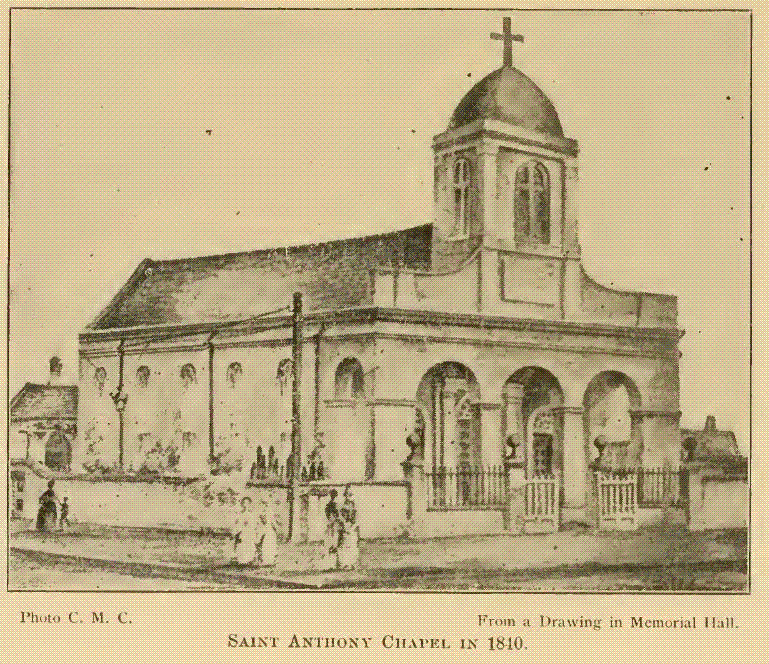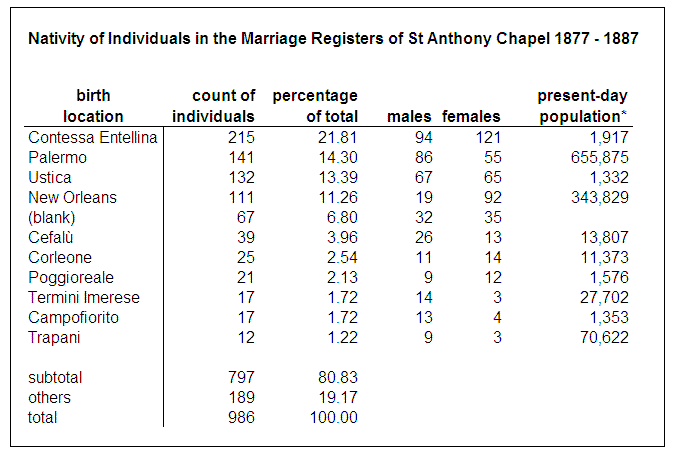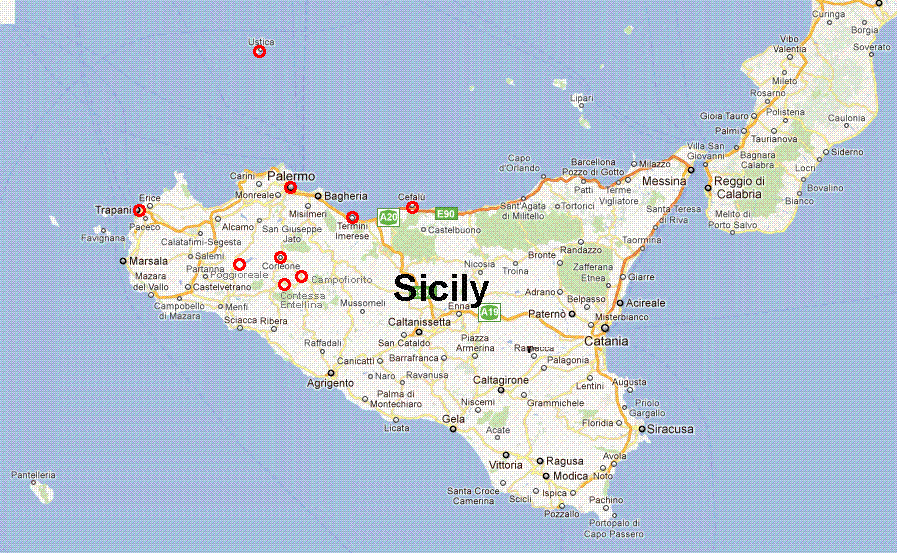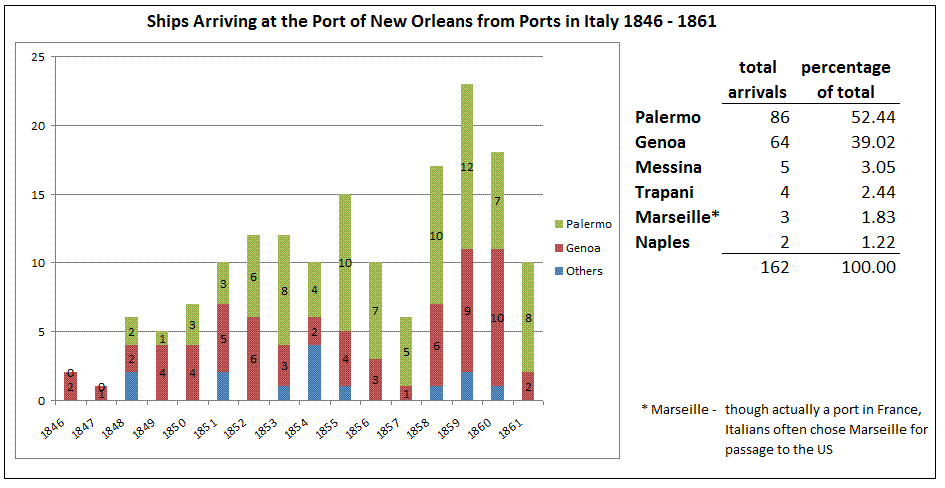Newsletter of the Congregazione di San Bartolomeo Apostolo
Issue 11 - 03 August 2011
| Analysis of the Marriage Registers of St Anthony's Chapel and What It Reveals About the Composition of the 19th Century Italian Immigrant Community of New Orleans By Chris Caravella St Anthony Chapel was one of the earliest churches dedicated solely to the Italian immigrant community in New Orleans and its marriage registers provide a rare opportunity to define the make-up of the community in the mid to late 1800's. The marriage registers of St Anthony Chapel list the actual hometown in Italy of the bride and groom, and there is no other local resource which provides that level of detail for this period in time in such a concentrated and comprehensive manner. The church was a focal point for Italian immigrants and statistics based on nativity listed in marriage records can be extrapolated to represent the overall composition of the Italian immigrant population in New Orleans. This analysis takes a scholarly approach to defining the community which previously has been described based on anecdotal and localized genealogical evidence. |
 i i
| St Anthony Chapel (currently Our Lady of Guadalupe Church), located at the corner of Rampart and Conti Streets, was built in 1827 as the mortuary chapel for St Louis Cemetery. It was not until the 1870ís that the church was designated for use by the growing Italian immigrant community under the direction of Father Giacomo Manorita ii. The first marriage registered during this period was in March 1873 and this record, as well as many following it, contain very little detail other than a date and the names of the bride and groom. Marriage details, such as age and nativity, are not consistently recorded until November 1877. Admittedly earlier data would better suit the purpose of this study, however, a time range of 10 years from 1877 to 1887 supplies a large enough dataset for analysis (986 individuals) and still avoids the diluting effect of the mass migration of Italians that would begin near the turn of the century and result in nearly 70,000 Italian immigrants passing through the port of New Orleans iii. To put this in perspective, the 1860 Census reveals 896 individuals of Italian birth living in Orleans Parish iv, by the 1880 Census that number was still relatively low at 2,167 v and at its peak in the 1910 Census the count grew to 8,065 iv. The following chart is a compilation of the number of individuals grouped by nativity as listed in the marriage registers for the years 1877 to 1887. The results are striking in how well they document significant migration patterns. |  * of the actual city in Sicily |
 Red circles mark cities in Sicily which were sources of early immigrants to New Orleans |
|
The most obvious trend is the dominance of Sicilians, in particular those exclusively from the northwest of Sicily centered on the city of Palermo. This makes sense in that Palermo is the largest city in Sicily and a major port. People wishing to emigrate from Sicily had a ready means of transport in the docks of Palermo and because of established trade routes, they also had a logical destination in the port of New Orleans. Also of note from the statistics is the large percentage of people with New Orleans listed as their birth location. Further examination of these records reveals that these surnames are 67% Italian. This is significant because it indicates that some 20 years earlier during the time when these individuals were being born in New Orleans, Italian families were already established in the city. 26% of the Italian surnames in this category match other surnames in the study attributed to Sicilian families. Although the dataset supporting this particular statistic is small, it still indicates that Sicilian families were established in New Orleans prior to the advent of the Civil War in 1861. Taking into account that the port of New Orleans was closed from 1861 to 1865 and that the immigration of women and children would follow the earlier immigration of solely men, it is reasonable to assert that the Sicilian migration began even earlier.
An examination of passenger lists of ships arriving at the port of New Orleans from 1846 to 1861 supports these findings vii. 52% of ships embarking from Italy did so from the port of Palermo. Genoa, a port city in Northern Italy, is the only other Italian city with a regular trade route to New Orleans during this time period and though some ships included hundreds of passengers, any substantial settlement of immigrants from that region is not reflected in the marriage registers of St Anthony's Chapel. By contrast, numbers of passengers on ships from Palermo rarely exceed 30 viii, yet these are the people, mostly males, that were settling in New Orleans and eventually attracting family and friends to join them.  Based on the results of this analysis, it comes as no surprise that benevolent societies established by immigrants from Cefalý (1887) ix, Contessa Entellina (1886) x and Ustica (1879) xi were among the earliest to be organized and among the very few which still remain viable to this day. The communities of Contessa Entellina and Ustica are particularly noteworthy in the disproportion of the size of their New Orleans community with the population of their hometowns in Sicily. One would expect that larger cities, like Palermo, would be represented in any analysis of the Sicilian immigrant population of New Orleans but Contessa Entellina and Ustica never had populations greater than a few thousand xii xiii . Ustica, in fact, is an island only 2 miles across, yet, its small size and limited resources are exactly what propelled the early exodus from the island starting as early as the 1830's to not only New Orleans, but also California, other remote islands in Italy, such as Lampedusa, and across French North Africa in the towns and villages of Algeria and Tunisia xiv. Why so many left so early from Contessa Entellina and the other Sicilian communities represented in New Orleans is unknown but all the early migrations can in great part be attributed to the war to unify Italy throughout the 1850ís and 1860ís. Many Sicilians considered this a foreign invasion and the threat of forced inscription of Sicilian males into the Italian army certainly drove many to flee. But even this does not account for the over-representation of just a few Sicilian communities in New Orleans. Perhaps it was enough that just the ready availability of the port of Palermo and strong ties that bound Sicilians to their hometown would create the right environment for them to congregate and prosper in their new home in New Orleans. These distinct Sicilian immigrant communities were the first to be established in New Orleans and by the advent of the great mass migration at the end of the century, their numbers had swelled, their communal network was complete and their integration into the social fabric of New Orleans was firmly established. In many ways they represent a distinct sub-group of the Italian American experience in New Orleans. One that has been somewhat overshadowed by the later migration, but, thankfully, well documented in the pages of the marriage registers of St Anthony's Chapel. Footnotes:
i Rev. C. M. Chambon, In and Around the Old St Louis Cathedral of New Orleans (New Orleans, LA: Phillipe's Printery, 1908) p. 125 | |||||